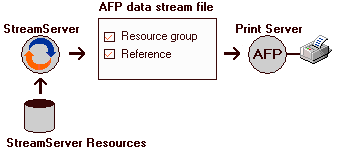The AFP driver can use several modes to handle resources. You can specify a default mode used to handle the resources, and then for each resource type specify other options that override the default options.
The Embed mode is the default mode. It converts the original resources to AFP resources, and wraps the AFP resources into the resource group in the AFP data stream file.

|
2
|
The StreamServer generates an AFP resource with a unique name, and wraps the AFP resource into the resource group in the AFP data stream file.
|
|
3
|
The StreamServer adds the unique name as a reference on the corresponding page definition in the AFP data stream file.
|
|
4
|
The StreamServer continues to generate and wrap AFP resources and add references for all the resources it finds.
|
|
6
|
When the Print Server finds a reference in the AFP data stream file, it retrieves the corresponding resource from the resource group in the AFP data stream file.
|
The Include mode enables the use of external resources (3rd party or modified resources). This mode requires that the external resources are included in the resources storage used by the StreamServer.

|
2
|
The StreamServer generates a unique name for the resource, retrieves the corresponding AFP resource from the resources storage, and wraps it into the resource group in the AFP data stream file.
|
|
3
|
The StreamServer adds the unique name as a reference on the corresponding page definition in the AFP data stream file.
|
|
4
|
The StreamServer continues to retrieve and wrap AFP resources, and add references for all resources it finds.
|
|
6
|
When the Print Server finds a reference in the AFP data stream file, it retrieves the corresponding resource from the resource group in the AFP data stream file.
|
|
Note:
|
The names of the resources in the resources storage must correspond to the resource names generated by the StreamServer.
|
The Reference mode can be used to optimize conversion speed, the size of the AFP data stream file, and resource loading on the printer. This mode requires that the resources are included in the resources storage used by the Print Server.

|
2
|
The StreamServer generates a unique name for the resource, and adds this name as a reference on the corresponding page definition in the AFP data stream file.
|
|
5
|
When the Print Server finds a reference in the AFP data stream file, it retrieves the corresponding resource from the resources storage.
|
|
Note:
|
The names of the resources in the resources storage must correspond to the resource names generated by the StreamServer.
|
The Merge mode merges images and overlays as bitmaps directly on a page definition. This mode can be used for unique images/overlays that are not shared by several page definitions.

|
2
|
The StreamServer generates a bitmap, and merges the bitmap on the corresponding page definition in the AFP data stream file.
|
|
3
|
The StreamServer continues to generate and merge bitmaps for all resources it finds.
|
The Export mode can be used to generate AFP resource files. The generated files can be uploaded to the resources storage used by the Print Server, and later be used with the Reference mode. The resource files can also be modified, and later be used with the Include mode.

|
2
|
The StreamServer generates an AFP resource with a unique name, and exports the resource to a file in the resources storage used by the StreamServer.
|
|
3
|
The StreamServer continues to generate and export AFP resources for all resources it finds.
|
The Ignore mode is only applicable to image, overlay, and formdef resources. It can be used during development to ignore temporary problems with resources. It can also be used during production where the corresponding resources are pre-printed on paper.

|
2
|
The StreamServer ignores the resource, and adds no resource information to the AFP data stream file.
|





